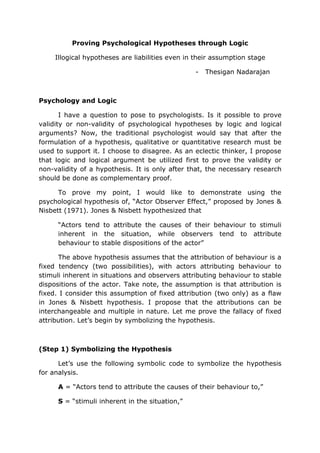
Proving psychological hypotheses through logic
- 1. Proving Psychological Hypotheses through Logic Illogical hypotheses are liabilities even in their assumption stage - Thesigan Nadarajan Psychology and Logic I have a question to pose to psychologists. Is it possible to prove validity or non-validity of psychological hypotheses by logic and logical arguments? Now, the traditional psychologist would say that after the formulation of a hypothesis, qualitative or quantitative research must be used to support it. I choose to disagree. As an eclectic thinker, I propose that logic and logical argument be utilized first to prove the validity or non-validity of a hypothesis. It is only after that, the necessary research should be done as complementary proof. To prove my point, I would like to demonstrate using the psychological hypothesis of, “Actor Observer Effect,” proposed by Jones & Nisbett (1971). Jones & Nisbett hypothesized that “Actors tend to attribute the causes of their behaviour to stimuli inherent in the situation, while observers tend to attribute behaviour to stable dispositions of the actor” The above hypothesis assumes that the attribution of behaviour is a fixed tendency (two possibilities), with actors attributing behaviour to stimuli inherent in situations and observers attributing behaviour to stable dispositions of the actor. Take note, the assumption is that attribution is fixed. I consider this assumption of fixed attribution (two only) as a flaw in Jones & Nisbett hypothesis. I propose that the attributions can be interchangeable and multiple in nature. Let me prove the fallacy of fixed attribution. Let’s begin by symbolizing the hypothesis. (Step 1) Symbolizing the Hypothesis Let’s use the following symbolic code to symbolize the hypothesis for analysis. A = “Actors tend to attribute the causes of their behaviour to,” S = “stimuli inherent in the situation,”
- 2. O = “Observers tend to attribute behaviour to,” D = “stable dispositions of the actor,” . = “While (and)” E = “Actor Observer Effect” Having symbolized the hypothesis, let us now draw-up the symbolic formula. (Step 2) Symbolic Formula of the Hypothesis The formula can be stated as: [(A.S).(O.D)] The English interpretation of the above formula is, Actors tend to attribute the causes of their behaviour to stimuli inherent in the situation, while observers tend to attribute behaviour to stable dispositions of the actor Next, I would like to prove Jones & Nisbett argument as flawed. (Step 3) Actor Observer Effect Hypothesis: Arguments and Counter arguments Jones & Nisbett Argument Jones & Nisbett single step argument can be described in the following manner. [(A.S).(O.D)] E Counter Argument: Deductively speaking, in order for Jones & Nisbett’s argument to be valid, all of its premises and its conclusions must be true.
- 3. p q p ___ /∴ q If either is proven doubtful or untrue, then, their argument is not valid. p q ~p ___ /∴ ~q Jones & Nisbett have committed the fallacy of “False Argument” in assuming that their hypothesis is exclusive without the possibility of alternate premises and conclusions. Let me prove it. Why didn’t they show other premise combinations of (A.S).(O.D)]? For example, the other possibilities are: 1. [(A.D).(O.S)] 2. [(A. (D V S)] 3. [(O. (D V S)] If we were to interpret in English, the other possibility goes like these: 1. Actors can attribute the causes of their behaviour to their stable dispositions, and observers can attribute their behaviour to stimuli inherent in the situation. 2. Actors can attribute the causes of their behaviour to their stable dispositions, or to stimuli inherent in the situation. 3. Observers can attribute the causes of their behaviour to their stable dispositions, or to stimuli inherent in the situation. I can therefore present my counter argument diagrammatically as follows:
- 4. [(A.D).(O.S)] [(A. (D V S)] [(O. (D V S)] _________________________________________ [(A.S).(O.D)] E By excluding all the above possibilities, they have bias their research and findings, by arbitrarily focusing only on proving [(A.S). (O.D)]. Therefore, both their premises and conclusion is faulty. My logical argument against the fixed (two) attribution differentiation is also supported by current researches like Hilton (2006) and Knobe & Nelson (2007) that shows other attribution possibilities. When a hypothesis does not even stand-up to a logical argument, what is the use of researching for support to scaffold it? Illogical hypotheses are liabilities even in their assumption stage. The logical analysis of hypotheses should always come first before the beginning of any research.
